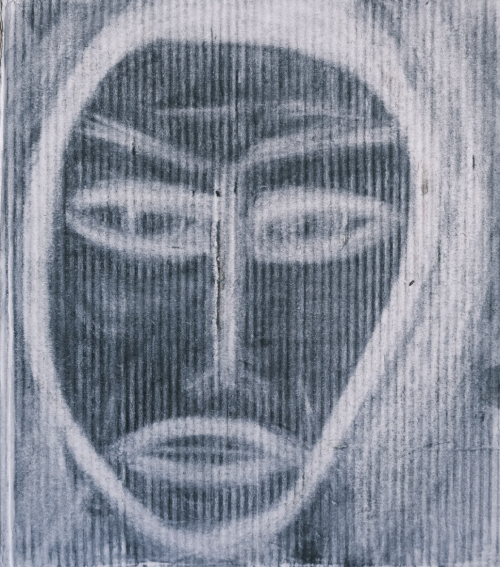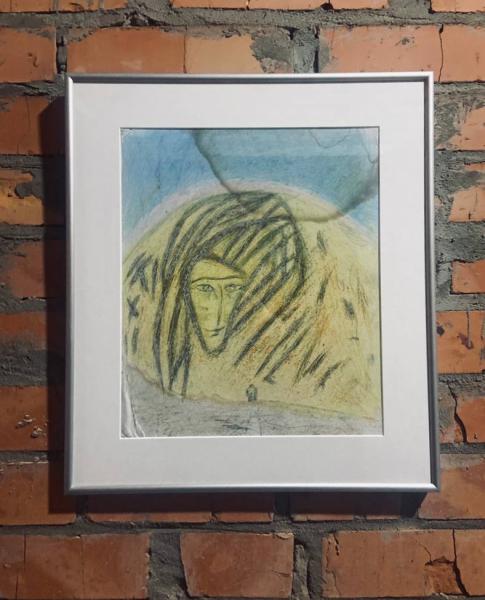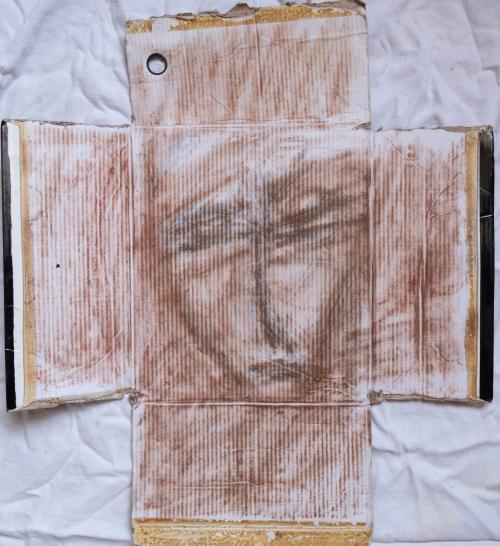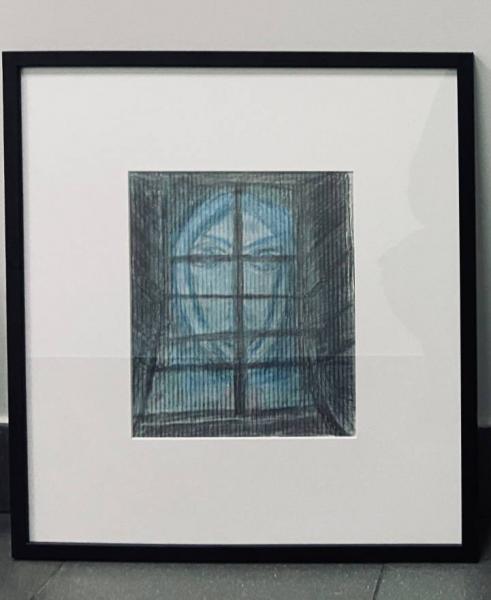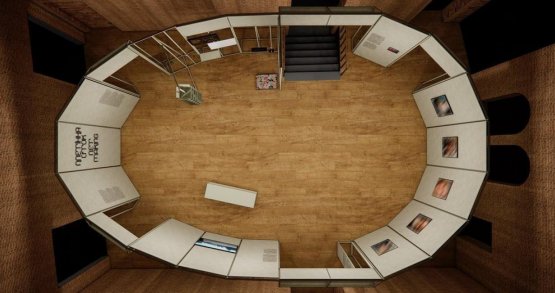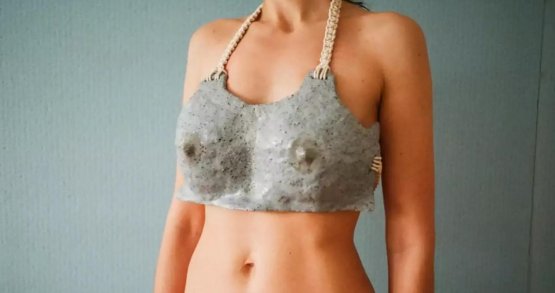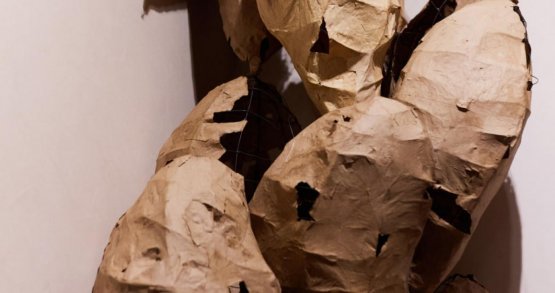This text is a commentary on the exhibition "There Was an Artist Here," dedicated to the outsider artist from Ivano-Frankivsk, Oleh Parfyonov, known as "Parfyon." Asortymentna Kimnata and Rostyslav Shpuk jointly organized the exhibition with the support of the Ivano-Frankivsk Museum of Local History and ran from August 11 to 29. The exhibition was based on 11 private collections of Rostyslav Shpuk, Taras Prokhasko, Yurii Izdryk, Nikita Kadan, Anatolii Zvizhynskyi, Khrystyna Mykhailiuk and Mirek Bodnar, Yurii Bakai, Oleh Hnativ (Mokh), Oksana Brynska, Olesia Sayenko and Aliona Karavai. According to Zbruc, Oleh Parfyonov — better known as Parfyon — was a musician and artist who was born in Leningrad in 1954, lived and worked in Ivano-Frankivsk for most of his life, and died in Frankivsk in December 2014. He often said that his grandfather was a conductor of the Berlin Opera. Parfyon stopped playing due to the lack of infrastructure and sought other ways of creative expression, such as through clothing and drawings.
I do not have the picture at hand, so I am reconstructing from my memory: the image is divided into three levels, three layers. The first is a background of relatively evenly smeared light red — or rather, more exactly, a red color of it is somewhat pale and muddy but becomes clear through the presence of the next layer, a green structure resembling either three spirals or a bizarrely deformed ribcage with its rhythm of curved ribs, although there is no trace of a spine. The red is animated and activated by the neighboring green. Lastly, the closest to our eyes, is a layer of distinct black lines, outlining the face/mask. The face’s shape approaches a triangle, it is tightly fitted within the rectangle of the sheet of paper, leaving very little space around it. Each eye is formed by two parallel diagonal lines, dashing from the bridge of the nose sideways and upwards. There is no contour of a closed eye, drawn to help us imagine the gaze as something separated from the mask, to imagine the gaze from under the mask. There is an expression of non-human anger, some angelic fury. Angelic because it is calm. This face would cut through other faces like a knife. At the same time, it is unalterable, it resides within the realm of pure potentiality. A knife as a possibility. Thus, presence becomes ultimate/unconditional.
Unapproved. Notes to you, to myself, and to some extent to all of them
28 march, 2024
* * *
“You” as you. (you change, you transform sometimes, your name and face flow, they float, which is one of the most common motifs in dreams). “You” as an appeal to yourself. “They” as a figure of threat, and, at the same time, those who seem to have accidentally come across this text.
Something along the lines of “art is not made for you to look at but still you can see it” or “not viewers but witnesses.”
My rose didn’t bloom for you, but, but…
* * *
Let’s say you (“you”) are an alcoholic on the street somewhere. This “somewhere” is Ivano-Frankivsk in our case. You are a Russian-speaker. You stink. Your past includes Leningrad and some inconsequential songs sung to a piano accompaniment. You put on fucked-up outfits from random junk, dramatizing your appearance, your street style. You are the city’s beloved madman. “Beloved” might just mean that people don’t take much notice of you, i.e, they do you no harm. Moderate neglect as the granting of the right to exist, not the kind of neglect that is a way of slowly killing. By and large, you are very, very lucky.
* * *
As is known, artists can be responsible citizens, parasites, queers, red-faced cis men, successful members of the middle class who are creative thinkers, Soviet fetishists, sieg-heilers, tricksters, left-wingers and moonlighters, ethno-nationalists, transhumanists, Ukrainian Galicians, laborers and villagers, and members of subcultures. But also, curb sleepers, remnants of past epochs, descendants of occupiers, or participants of struggles for liberation, speakers of the nightingale language of song, be it pop music or prison shanties, social media influencers, wackos, Cassandras, children of God, moral paragons, etc. There is no end to this list, there just isn’t.
* * *
The inclination and capacity to break the line is generally punishable, and, as a human being, you’d better not have any overly distinct contours if you want to avoid punishment. The flipside of this is that there is a fairly widespread and unhealthy interest in the things produced by those with this capacity. So it’s necessary to work out a certain strategy for slinking by, shedding your skin in order to leave them with something in their hands. “Has been giving away, exchanging for support,” this writer saw it all up close. All this is true, but that’s what the working mechanism is — you give the picture away so as not to give yourself away too soon. You can’t run forever but at least you can buy some time.
Pictures will remain. The things they contain (if they contain anything at all, since this process is a shot in the dark) will reshape the line, they might even expand it dramatically. The horizon will become higher, there will be more air. While you will have vanished into thin air. An uncatchable Joe (a character from a Russian joke about American cowboys, used to describe a person who overestimates his own importance in the eyes of others while simply being not interesting to others — ed.).
“A man of genius is unbearable unless he possesses at least two other things: gratitude and purity,” from Nietzsche, “The Gay Science.” Please do not use this as an epigraph, it’s already threadbare. And epigraphs like that are basically not your generation’s style.
As for the exchange of gratitude/support, seemingly, there is no commonly accepted conversion rate. Right up to the end, it will not be clear whether he paid in trifling souvenirs or actual blood.
Or, he may have even wanted to give away blood for some reasons that are unclear, or possibly reasons that would merit disapproval.
“You” as you. (you change, you transform sometimes, your name and face flow, they float, which is one of the most common motifs in dreams). “You” as an appeal to yourself. “They” as a figure of threat, and, at the same time, those who seem to have accidentally come across this text.
Something along the lines of “art is not made for you to look at but still you can see it” or “not viewers but witnesses.”
My rose didn’t bloom for you, but, but…
* * *
Let’s say you (“you”) are an alcoholic on the street somewhere. This “somewhere” is Ivano-Frankivsk in our case. You are a Russian-speaker. You stink. Your past includes Leningrad and some inconsequential songs sung to a piano accompaniment. You put on fucked-up outfits from random junk, dramatizing your appearance, your street style. You are the city’s beloved madman. “Beloved” might just mean that people don’t take much notice of you, i.e, they do you no harm. Moderate neglect as the granting of the right to exist, not the kind of neglect that is a way of slowly killing. By and large, you are very, very lucky.
* * *
As is known, artists can be responsible citizens, parasites, queers, red-faced cis men, successful members of the middle class who are creative thinkers, Soviet fetishists, sieg-heilers, tricksters, left-wingers and moonlighters, ethno-nationalists, transhumanists, Ukrainian Galicians, laborers and villagers, and members of subcultures. But also, curb sleepers, remnants of past epochs, descendants of occupiers, or participants of struggles for liberation, speakers of the nightingale language of song, be it pop music or prison shanties, social media influencers, wackos, Cassandras, children of God, moral paragons, etc. There is no end to this list, there just isn’t.
* * *
The inclination and capacity to break the line is generally punishable, and, as a human being, you’d better not have any overly distinct contours if you want to avoid punishment. The flipside of this is that there is a fairly widespread and unhealthy interest in the things produced by those with this capacity. So it’s necessary to work out a certain strategy for slinking by, shedding your skin in order to leave them with something in their hands. “Has been giving away, exchanging for support,” this writer saw it all up close. All this is true, but that’s what the working mechanism is — you give the picture away so as not to give yourself away too soon. You can’t run forever but at least you can buy some time.
Pictures will remain. The things they contain (if they contain anything at all, since this process is a shot in the dark) will reshape the line, they might even expand it dramatically. The horizon will become higher, there will be more air. While you will have vanished into thin air. An uncatchable Joe (a character from a Russian joke about American cowboys, used to describe a person who overestimates his own importance in the eyes of others while simply being not interesting to others — ed.).
“A man of genius is unbearable unless he possesses at least two other things: gratitude and purity,” from Nietzsche, “The Gay Science.” Please do not use this as an epigraph, it’s already threadbare. And epigraphs like that are basically not your generation’s style.
As for the exchange of gratitude/support, seemingly, there is no commonly accepted conversion rate. Right up to the end, it will not be clear whether he paid in trifling souvenirs or actual blood.
Or, he may have even wanted to give away blood for some reasons that are unclear, or possibly reasons that would merit disapproval.
* * *
Fluidity as the main prerequisite. The need to flow, the need to change masks. This is both a language (more precisely, a personal dialect) and a survival technique. But even your own material might betray you. Shells dry out, surfaces crack. You drank and used too much. You looked too much for experiences outside as well. You are intoxicated and contaminated inside and out. And still, you should be fluid even in your disintegration. Be it physical or mental. Collage and reassemble yourself into other combinations, even if you are already falling apart. Scary indeed, but this gift could have easily not been yours. Well, now it seems that the reasons to be scared are somewhat different, are they not?
For some, a mental disorder might even stand for rescue. But not for you, no. For you, it’s another vantage point from which you can see.
Don’t be ashamed of the basics of romanticism. Rearrange the context and collage them with things that romanticism itself could not have seen.
Conservative romanticism and reparative reading.
Unnamed bodies, queered by the very pit they've been dumped into. Have you said it? You have said it. Lyolia has said it. Someone called Stropov also said it at some point. But looking for precedence here is the most comical thing. Dead queers do not enjoy any authorship.
And now do measure the distance between yourself and the pit. Consider the change in the dynamics of that distance, of that pulsating length.
Consider the point of view of those who fly above the pit.
You are me. You are me.
Fluidity as the main prerequisite. The need to flow, the need to change masks. This is both a language (more precisely, a personal dialect) and a survival technique. But even your own material might betray you. Shells dry out, surfaces crack. You drank and used too much. You looked too much for experiences outside as well. You are intoxicated and contaminated inside and out. And still, you should be fluid even in your disintegration. Be it physical or mental. Collage and reassemble yourself into other combinations, even if you are already falling apart. Scary indeed, but this gift could have easily not been yours. Well, now it seems that the reasons to be scared are somewhat different, are they not?
For some, a mental disorder might even stand for rescue. But not for you, no. For you, it’s another vantage point from which you can see.
Don’t be ashamed of the basics of romanticism. Rearrange the context and collage them with things that romanticism itself could not have seen.
Conservative romanticism and reparative reading.
Unnamed bodies, queered by the very pit they've been dumped into. Have you said it? You have said it. Lyolia has said it. Someone called Stropov also said it at some point. But looking for precedence here is the most comical thing. Dead queers do not enjoy any authorship.
And now do measure the distance between yourself and the pit. Consider the change in the dynamics of that distance, of that pulsating length.
Consider the point of view of those who fly above the pit.
You are me. You are me.
* * *
Here’s you (“you” — the face and name change here) gobbling down a pack or two of Lyrica in one go. Washing it down with booze. Turning into a child. You’ll be like “hey, love me the way I want you to, or I’ll get scary on you.” But art that belongs to you and you alone will pick you up, will hold you tight, giving back your own breathing, your own thoughts. When there are those smoky drawings out there, those notepads, those body rooms and face rooms, those small legs-tables-boxes, those pocket exhibitions, all pierced with sharp wooden splinters — you can no longer run away from yourself, you can’t be alone. You can play the fool, or ask to be taken into someone’s arms. But higher love is already near. Your own thought is there, it has already surfaced and is thinking itself all on its own. It will always take care of you.
Here’s you (“you” — the face and name change here) gobbling down a pack or two of Lyrica in one go. Washing it down with booze. Turning into a child. You’ll be like “hey, love me the way I want you to, or I’ll get scary on you.” But art that belongs to you and you alone will pick you up, will hold you tight, giving back your own breathing, your own thoughts. When there are those smoky drawings out there, those notepads, those body rooms and face rooms, those small legs-tables-boxes, those pocket exhibitions, all pierced with sharp wooden splinters — you can no longer run away from yourself, you can’t be alone. You can play the fool, or ask to be taken into someone’s arms. But higher love is already near. Your own thought is there, it has already surfaced and is thinking itself all on its own. It will always take care of you.
* * *
Outsider art, naïve art are colonialist, Nazi terms. Art brut seems to be slightly better until the term’s coiner comes into the picture. A being so poncy as to allow themselves to indulge in a taste for rawness. Someone who will imitate crudity, wildness so perfectly that you will fail to notice. Or will pick up their game and pretend to not have noticed.
You have to choose here: either Dubuffet's portrait of Artaud or self-portraits of Artaud. And yes, your infinite masks.
Artaud, Unica Zurn and you.
It would be great to hang just three pictures. You take a look — and it seems that no explanations are needed.
Dubuffet would like to be you, or at least to be Artaud. He wanted to crawl back into the mommy of madness, but would it have been his own? He wanted anti-culture — in the sense of loosening his tie a bit. But not to the extent of losing control over the process. But it does not work this way. Kulturträgership and charity is what remains. However, oppositions like “Western world — primitive man” will yeild various new levels of disguise. One can polish up anything in the “emancipatory” style but liberation is where language stands against itself.
Naming always points to the place from which the name is uttered. Adam gives names to all cattle and birds of heaven. You say “art brut,” and you will never be able to become it yourself. So, it’s better to stick to the “apophatic” line. To find cracks to escape between names that are already available. Still, it is necessary to define all this somehow so that it does not perish. Because things that are left undefined are hauled off to the dump. Because undefined beings are driven out of this world.
Unapproved art. Instead of all “outsider art,” instead of “naiveté” with a clinical flavor, projected onto you and outside.
The people who made these pictures simply did not coordinate with you — they did not even try to coordinate. They decided on their own what these pictures should be like. They did not ask for permission. They did not ask for the opinion of the art community. They did not justify themselves. That’s essential.
And that’s the only part that can be used as an example. In all other aspects, this knowledge is not fit for common usage.
Each picture of yours is a way out, but nobody will ever follow you there.
Unapproved art.
* * *
Being with art means (yes, among other things) “not tiptoeing around life.” Without mutual surveillance, without self-censorship. Without vigorous democratic discussions (known to be toxic sometimes, but full of care and mutual support). Cultural constructs are another things, where it is worthwhile to do your duty with integrity and produce sufficient social cohesion. At least in order not to drop dead prematurely under a pile of dirty rags.
Outsider art, naïve art are colonialist, Nazi terms. Art brut seems to be slightly better until the term’s coiner comes into the picture. A being so poncy as to allow themselves to indulge in a taste for rawness. Someone who will imitate crudity, wildness so perfectly that you will fail to notice. Or will pick up their game and pretend to not have noticed.
You have to choose here: either Dubuffet's portrait of Artaud or self-portraits of Artaud. And yes, your infinite masks.
Artaud, Unica Zurn and you.
It would be great to hang just three pictures. You take a look — and it seems that no explanations are needed.
Dubuffet would like to be you, or at least to be Artaud. He wanted to crawl back into the mommy of madness, but would it have been his own? He wanted anti-culture — in the sense of loosening his tie a bit. But not to the extent of losing control over the process. But it does not work this way. Kulturträgership and charity is what remains. However, oppositions like “Western world — primitive man” will yeild various new levels of disguise. One can polish up anything in the “emancipatory” style but liberation is where language stands against itself.
Naming always points to the place from which the name is uttered. Adam gives names to all cattle and birds of heaven. You say “art brut,” and you will never be able to become it yourself. So, it’s better to stick to the “apophatic” line. To find cracks to escape between names that are already available. Still, it is necessary to define all this somehow so that it does not perish. Because things that are left undefined are hauled off to the dump. Because undefined beings are driven out of this world.
Unapproved art. Instead of all “outsider art,” instead of “naiveté” with a clinical flavor, projected onto you and outside.
The people who made these pictures simply did not coordinate with you — they did not even try to coordinate. They decided on their own what these pictures should be like. They did not ask for permission. They did not ask for the opinion of the art community. They did not justify themselves. That’s essential.
And that’s the only part that can be used as an example. In all other aspects, this knowledge is not fit for common usage.
Each picture of yours is a way out, but nobody will ever follow you there.
Unapproved art.
* * *
Being with art means (yes, among other things) “not tiptoeing around life.” Without mutual surveillance, without self-censorship. Without vigorous democratic discussions (known to be toxic sometimes, but full of care and mutual support). Cultural constructs are another things, where it is worthwhile to do your duty with integrity and produce sufficient social cohesion. At least in order not to drop dead prematurely under a pile of dirty rags.
* * *
If you live in fear, you'll die of fear. But: “Blessed is he who has known great fear. In it lies uninhibitedness.” Those are the words of Oleh Holosii, not exactly a verbally active artist. “In zis zer is uninhibitednez.” Would you like this version better? (in the original version of the text the author injects a mocking use of Russian accent that became gradually normalized after the full-scale Russian invasion of Ukraine —ed.)
Your flow of faces — that’s after fear. On the other side. That grand immodesty, open-mindedness, unselfconsciousness.
The same writer says: “At some point, he saw the most frightful thing — how human the devil looks. So, he painted his images as if he were a sketch artist for Interpol.”
But “the devil” — presumably that’s something separate, an extra element? And here we have faces, nearby and all around, each and every day, far-off and familiar. There’s a density, even an overcrowding in this world of faces.
I guess this was your struggle for your own face.
* * *
Old smelly madman, how easy it is to love you without having seen or known you!
If you live in fear, you'll die of fear. But: “Blessed is he who has known great fear. In it lies uninhibitedness.” Those are the words of Oleh Holosii, not exactly a verbally active artist. “In zis zer is uninhibitednez.” Would you like this version better? (in the original version of the text the author injects a mocking use of Russian accent that became gradually normalized after the full-scale Russian invasion of Ukraine —ed.)
Your flow of faces — that’s after fear. On the other side. That grand immodesty, open-mindedness, unselfconsciousness.
The same writer says: “At some point, he saw the most frightful thing — how human the devil looks. So, he painted his images as if he were a sketch artist for Interpol.”
But “the devil” — presumably that’s something separate, an extra element? And here we have faces, nearby and all around, each and every day, far-off and familiar. There’s a density, even an overcrowding in this world of faces.
I guess this was your struggle for your own face.
* * *
Old smelly madman, how easy it is to love you without having seen or known you!
* * *
Parfyon died, the russian bastards attacked, and the teeny-weeny art community was bitten by a cop.
That’s the end of the story, or so it would seem.
But there are green spirals against the red background, cinched tight under the mask assembled from sharp black lines, and a cross of a window frame over a huge blue face peeking into that window from outside. There are red and rose strokes running down along the grey and brown background, and there are chaotic black strokes, with orange and emerald blazing out from under them. There are broken lines and coiled lines. There are glances like nails with their points facing outwards, and there are empty little eyes. There are faces attacking from the surface, and those dragging you away behind that same surface.
There is something that had not been before you and will never be again after you. Salvation is here.
Parfyon died, the russian bastards attacked, and the teeny-weeny art community was bitten by a cop.
That’s the end of the story, or so it would seem.
But there are green spirals against the red background, cinched tight under the mask assembled from sharp black lines, and a cross of a window frame over a huge blue face peeking into that window from outside. There are red and rose strokes running down along the grey and brown background, and there are chaotic black strokes, with orange and emerald blazing out from under them. There are broken lines and coiled lines. There are glances like nails with their points facing outwards, and there are empty little eyes. There are faces attacking from the surface, and those dragging you away behind that same surface.
There is something that had not been before you and will never be again after you. Salvation is here.
To read more articles about contemporary art please support Artslooker on Patreon
Share:

